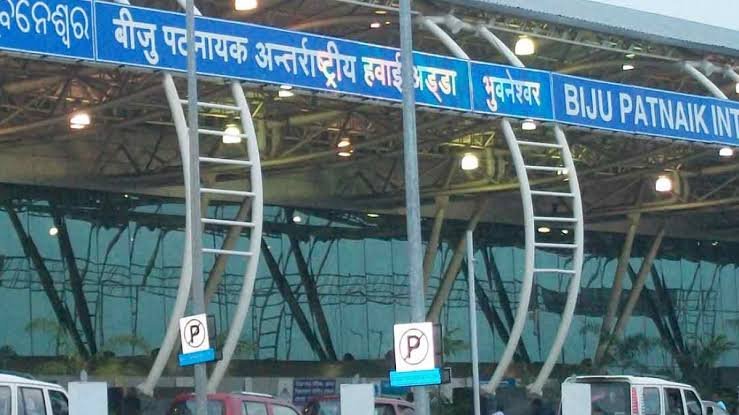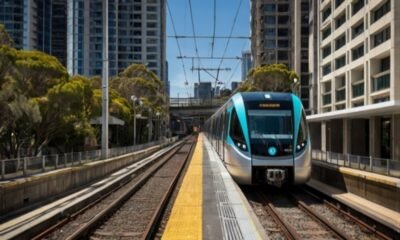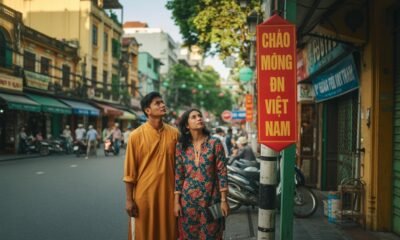Travel Guides & Articles
Now, South Korea Flights Disrupted as Torrential Rains Cause Floods and Landslides: Weather Updates and Travel Impact, Here is Everything You Need to Know

Monday, July 21, 2025
One of South Korea’s worst summer rains has taken a heavy toll on air travel, with floods and landslides playing havoc with travel plans. It left the country drenched by heavy rains for days, causing extensive infrastructure damage — to airports and roads in particular. Here’s what we know about how the torrential rains are impacting flights, what the weather is likely to have in store and what travelers can expect given the developing situation.
Torrential Rain and Floods Scrub South Korea’s Flights
An enormous outburst of precipitation struck southern Korea from Wednesday, July 17 to Sunday, July 20; some areas saw 600-800 mm of precipitation fell, unprecedented in volume. The excessive rain caused floods and multiple landslides that affected the country travel infrastructure on a massive scale, affecting all means of transportation, especially air travel. Airports in the affected regions experienced flight delays, including Incheon International Airport in Seoul, Gwangju Airport and Daegu International Airport.
Airlines providing flights to and from South Korea had to cancel or reschedule a number of flights as the floodwaters rose at alarming speed. Flight take-offs were delayed by heavy rain which choked traffic on the roads to the airports and passengers struggled to get to the terminals on time. At Gwangju Airport, a major transit center in the south, workers scrambled to ensure the safety of passengers, even as many flights were delayed.
Shutting airport and flight disruption in view of landslides
Mudslides prompted by the heavy rain also added to the chaos. Southern South Korea – Sancheong Town This town in the south of the country was home to deadly landslides that killed many and left behind a great deal of destruction. The land and mud slides cut off access to some local airports, including at Gwangju and Daegu, stranding passengers trying to make their way out of harm’s way.
Occassionally, they had to stop the ground services for the residents and aircraft failed to take off and land on their ground. Seoul’s Incheon International Airport was late to the game, delaying schedules as arriving flights attempted to reroute, in ways that prolonged the travel for a lot of passengers.
Next: Evacuation and a Blow to the Airport
About 3,800 people throughout South Korea have been forced to flee their homes from floodwaters, and many took refuge in emergency shelters hastily organized in temporary spaces near the airports, the officials said. That resulted in ripples being sent through their operations, causing some workers and passengers to be stuck at or unable to reach flights.
Though airlines have tried to minimize the disruptions, many travelers were rebooking flights to their destinations, adding to the headaches and confusion. Animals were stranded at farms as the waters rose, complicating the challenge of moving them and other goods, even by air cargo.
Travelers, Here’s What to Know Flight Updates and the Weather Forecast
The raining threat of heavy downpours has disappeared, and the weathermen are now forecasting a heat wave! But the ripple effects of the storms will continue to be felt in the scheduled flights in the coming days. Dozens of flights have been cancelled and delayed in the country, with domestic flights between the southern cities of Sancheong, Gwangju, and Daegu to Seoul among the most affected.
Travelers are already recommended to check with their individual airlines for the latest flight status. Carriers are offering refunds or revised tickets for passengers affected by the suspension. Weather advisories also will bear watching since the heat wave may result in other air-travel delays.
Flight Cancellations and Alternative Routes
Travellers arriving to and departing from Korea should practice a flexible travel plan. The rains and landslides have already caused jitters with domestic and international flights to and from the airport cancelled or delayed. Those who still must be motoring elsewhere can take alternate routes, but the travel times are not looking good.
Travelers transfering from airports in Seoul or other large airports to international hotspots in Asia such as Tokyo, Beijing and Hong Kong could also find alternative flights from neighboring airports. Most airlines have loosened their restrictions on rebooking long-haul flights to nearly any date, but available dates are limited so act fast.
Extreme Weather Forecast: What to Expect Next
‘Whether this weekend’s forecast is indicating no more intense rain but the heatwave after the rain is coming, and the temperature will rise to over 30 degrees It keeps being raining and hot as the temperature keeps rising It will probably make the traffic conditions worse. The sustained wetness would drive up the real-feel temperature, possibly adversely affecting air quality and recovery efforts across the airports, which might experience delays. Travelers can also anticipate that longer-than-normal waits — and possible delays — at security checkpoints are likely to persist for several days, as airports make a recovery from the impact of the storm.
South Korea Travel Tips: How to Prepare for Rainy Season
Here’s what travelers flying to or from South Korea in the days ahead can do to make their journey as smooth as possible:
Stay Informed: Keep an eye on your airline’s website and official South Korean government weather updates for real time updates about flight cancellations, delays and weather advisories.
Travel Flexibility: If possible, you may want to reschedule flights and steer clear of peak travel times when the storm’s aftermath is contributing to gridlock.
In case of a canceled or delayed flight: Consider all remaining options for transportation, if your flight is canceled or delayed, by bus or train.
Show Up Early: As things currently stand, anticipate delays at the airport and give yourself enough time for a security line and maybe a rescheduling.
Pack for Heat: Load up your carry-on with water and sunscreen, and wear light clothing in preparation, instead, for the excruciatingly long lines at the airport in the next few days.
What to Watch as South Korea Rebuilds Its Air Traffic
South Korea’s aviation in for turbulent period as recovery work kicks in. Airport officials are working to get as many flights back on schedule as quickly as possible, but passengers could experience delays, especially in the South.
In the medium and long run assistance will focus on restoring infrastructure, like access roads to airports, and the reconstructing of buildings in the affected areas. The coming weeks will be key in demonstrating how soon full flight operations can be resumed.
Conclusion: All travelers who are susceptible Must ALWAYS be prepared
The deadly South Korea floods and landslides have thrown air traffic into chaos, with many people left stranded or delayed. The worst of the rains may be over but their aftermath will likely still be impacting on flight delays. Travelers should also stay flexible and monitor their flights, and prepare for a heat wave that could add complications to air travel. But as the country works to move forward in that grieving process, do please keep updated on the situation, and to prepare for any more aftershocks.
Source Credit: www.abc.net.au
Travel Guides & Articles
Ranchi Airport eyes growth with new connectivity plans

Ranchi’s Birsa Munda Airport is set to witness more flight operations soon, with a new transit service to Bhubaneswar already launched. According to airport director R. R. Mourya, four additional routes are currently under consideration, highlighting the airport’s aim to strengthen air connectivity across the region.
Currently, only two airlines operate flights from Ranchi, but there are expectations of increased activity in the upcoming winter schedule. Although exact destinations are yet to be confirmed, Mourya revealed that Akasa Air had earlier shown interest in Ranchi operations, though the plan did not materialise.
The airport’s strong performance in passenger satisfaction has been another milestone. Rising from the 34th position last year to fifth place in the Airports Authority of India’s survey, the achievement reflects improved infrastructure and services. Mourya credited the efforts to enhance facilities, ensuring travelers have a more comfortable waiting experience.
Several infrastructural upgrades have been completed recently, including 300 square meters of new seating space and an additional lounge that was inaugurated last year. Food services have been expanded, and restroom renovations are already 70% finished. A dedicated parking zone for commercial vehicles has also been introduced.
Despite the optimism, Ranchi’s flight operations have temporarily decreased from 27 to 24. This drop is due to the reorientation and rescheduling of certain services. For instance, one route was shifted to Deoghar, while a Ranchi-Patna direct flight was restructured via Kolkata. However, Mourya assured that passenger convenience from Jharkhand remains unaffected.
Looking ahead, authorities plan to further upgrade passenger amenities within the next six to twelve months. With the addition of more airlines and continued infrastructure development, Ranchi’s Birsa Munda Airport is positioning itself as a rising hub in eastern India’s aviation network.
Travel Guides & Articles
The costliest chai in India: How credit cards sell you the lounge dream – Money Insights News

I open Twitter on travel days and see the same posts.
A tray of snacks, a cup of chai, soft chairs in the background, and a caption that says free lounge access with my card. Many people post it and celebrate it. I felt the same when I held multiple cards. Lounge entry felt like a small upgrade, so I told friends to get the same perk.
Then I started reading my statements line by line.
Annual fees after the first year. Spend targets to waive fees. Caps on visits that run out, too. Foreign currency markups on every swipe abroad. Reward values that shift without notice.
That is when I surrendered all my credit cards. I wrote about that decision here: I paid my bills on time and never paid interest. Here is why I quit credit cards anyway.
Since then I look at the lounge photo differently. The chai feels free in the moment, yet the bill often sits elsewhere. It sits in the annual fee. It sits in the spend you do only to keep a waiver. It sits in the forex markup that can exceed the value of the food on your plate. Miss one payment, and the interest can turn that visit into the costliest snack of the year.
This piece is a simple breakdown of that math. Before the next lounge selfie, it helps to ask one question. What did I truly pay for this plate and this chair.
The Annual Fee And The Spend Target
Let us start with the simplest cost. The fee.
When I held multiple cards, the first year felt easy. Free welcome, free visits, free chai. The second year was the turn. Renewal hit. I told myself the lounge perk made it worth it. Then I did the math.
A fee is not a line on a brochure. It is money out of your pocket. If a card costs a few thousand rupees and you visit a lounge three or four times in a year, you have already paid a high price per visit before you even sit down.
Many cards add a condition on top. Spend a large amount in the year and the fee will be waived. That sentence sounds harmless. In real life it changes behaviour.
Think about how people chase that target. I did it too. You bring forward purchases. You choose the card even when UPI or a debit card would have been cleaner. You add an extra order to a sale because the counter is close. You pay a bill early only to push the number up. None of these choices feel wrong in the moment. Together they create spend you would not have done at the same pace. The waiver feels like a win. The extra spend is the real payment.
Caps are the next surprise. Complimentary access is rarely open ended. There are quarterly limits or annual buckets. If your travel is lumpy, you can hit the cap in a single busy month. The next visit is billed. Add-on cards often draw from the same bucket, so a family of four can use up the allowance without noticing. The benefit that looked rich at sign-up becomes thin when you actually need it.
Here is a simple check you should use.
Ask yourself three questions.
- If the card had no lounge access, would I still pay this renewal fee.
- If the only reason I am swiping today is to hit a waiver, would I buy this item otherwise, at this time, at this price.
- If I expect two or three lounge visits in the year, would a direct paid entry on those days cost less than the fee.
Answering honestly is uncomfortable. It was for me. I realised I was paying for a feeling of access rather than a service I used often. That is why I surrendered my cards. If you fly every week, the math can favour a premium card. If you fly a few times a year, the fee and the target can turn a cup of lounge chai into an expensive habit.
In short, the bill for the lounge rarely shows up at the lounge. It hides in renewals, in targets that push spending, and in limits that reduce real use. Once you see that clearly, the next section becomes important. The foreign currency markup that attaches itself to every trip abroad.
The Foreign Currency Markup That Follows You Abroad
Think of a normal trip. You glide into the lounge, click a photo, sip chai, and board. The real bill starts after you land. Every coffee, taxi, museum ticket, and hotel swipe overseas carries a small extra line on your card. That line is the foreign currency markup.
Most Indian credit cards charge about 2 to 3.5 percent on every foreign transaction. Then GST gets added on that fee. The brochure writes it as a neat percentage. On a real trip it feels different.
I noticed this when I still had cards. One family trip. Roughly ₹1,20,000 spent abroad. My statement showed two extra lines I had ignored for years:
- International Markup Fee
- IGST on International Markup
At a 3.5 percent markup, that was ₹4,200. Add 18 percent GST on that fee, about ₹756 more. Total ₹4,956. No one at a counter asked me to pay it. It just appeared on the bill later. That single trip’s markup could have paid for a few lounge entries outright.
Where it adds up
- Every swipe overseas. Cafes, taxis, pharmacies, attractions.
- Online buys in foreign currency. Software, courses, subscriptions, hotel portals that bill in USD or EUR.
- Hotel deposits and car rentals. Pre-authorisations get added and released later. Rate changes in between can create small losses.
- Dynamic currency conversion. The terminal asks, “Pay in INR or pay in local currency.” Choose local currency. INR at the machine often bakes in a poor rate on top of the bank markup.
Run your own “trip test”
- Add up last trip’s foreign spends.
- Multiply by your card’s forex rate.
- Add 18 percent GST on that fee.
- Compare this number with what you actually ate and drank in lounges on that trip.
If the markup plus GST is bigger than your lounge consumption, then the lounge was not free. You paid for it through the markup.
Why this matters for lounge lovers
Many people keep a premium card mainly for international lounge access. The same card then collects 3 percent to 3.5 percent on almost every spend during the trip. If a family spends ₹1,50,000 abroad, a 3.5 percent markup plus GST is roughly ₹6,195. That is real money for a silent line item.
What about zero-forex cards
Some cards advertise zero forex markup. Read the conditions. Often there is a higher annual fee, a cap, or narrow categories. If you travel very often, a clean zero-forex product can work. If you take one or two trips a year, the fee can wipe out the benefit.
Small habits that save a lot
- Always choose to pay in the local currency on the terminal.
- Avoid cash withdrawals on credit cards overseas. Cash advance fees and interest start from day one.
- For online purchases, check the billing currency before you click pay.
- Keep one card for domestic use and one for foreign spends so you can track markups easily.
When I finally laid my statements side by side, the picture was clear. The lounge photo felt free. The markup paid the bill. This was one more reason I surrendered my cards. Next, let us talk about the slow leak that many people miss at home. Rewards that change value and give you less for the same fee.
Before You Renew: A Simple Audit That Works
One note before we wrap. I do not use credit cards now. I surrendered them. Still, I suggest this audit to anyone who cares about value. It is quick, honest, and helps you decide if lounge access is worth it for you.
The five-minute audit
- Count your lounge visits: Last twelve months only.
- Write the annual fee: For each card that promised lounge access.
- Per-visit cost: Fee divided by actual visits.
- Add the forex leak: On your last foreign trip, multiply total overseas spend by your card’s forex rate, then add 18 percent GST on that fee.
- Reality check: Is per-visit cost plus forex leak higher than what you actually ate or drank in lounges. If yes, the lounge is not free.
Small rules that save real money
- Do not chase fee waivers: If you are buying only to hit a target, count that extra spend as a cost.
- Track the cap: Quarterly or yearly limits apply. Add-on cards share the same pool.
- Kill markup at the counter: Always pay in local currency overseas. Avoid cash withdrawals on credit cards.
- Right tool for the job: Keep one simple card for daily use. Use a separate travel card only when you travel.
- Auto-pay in full: One late fee can wipe out a year of perks.
- Downgrade fast: If your fee per visit is high, ask for a waiver or move to a lower-fee product.
- Buy access when needed: If you expect two or three visits a year, paid entry on those days may cost less than a premium fee all year.
Disclaimer
Note: This article relies on data from fund reports, index history, and public disclosures. We have used our own assumptions for analysis and illustrations.
The purpose of this article is to share insights, data points, and thought-provoking perspectives on investing. It is not investment advice. If you wish to act on any investment idea, you are strongly advised to consult a qualified advisor. This article is strictly for educational purposes. The views expressed are personal and do not reflect those of my current or past employers.
Parth Parikh has over a decade of experience in finance and research. He currently heads growth and content strategy at Finsire, where he works on investor education initiatives and products like Loan Against Mutual Funds (LAMF) and financial data solutions for banks and fintechs.
Travel Guides & Articles
IRCTC to lead India’s participation at International Tourism Expo Vietnam 2025 with ASEAN-India Pavilion

NEW DELHI: The Indian Railway Catering and Tourism Corporation (IRCTC), a Government of India enterprise, has been entrusted with the responsibility of organising India’s participation in the prestigious International Tourism Expo (ITE) Vietnam 2025.
This comes after Prime Minister Narendra Modi announced 2025 as the ASEAN-India Year of Tourism, marking a renewed commitment by India to strengthen its cultural, economic, and tourism ties with ASEAN countries.
This expo is being organised from 4 to 6 September this year at the Saigon Exhibition and Convention Centre (SECC) in Ho Chi Minh City, Vietnam.
The Prime Minister’s bold proclamation essentially outlines the pivotal role of tourism in improving people-to-people connectivity, fostering mutual prosperity, and strengthening the bonds of friendship between India and the ASEAN countries.
According to an official source, IRCTC is setting up an exclusive ASEAN-India Pavilion that will showcase a diverse range of tourism offerings from India. These include the country’s rich cultural heritage, spiritual and wellness packages, natural beauty, adventure activities, and premium travel products such as the world-class IRCTC luxury trains: the Maharajas’ Express, the Golden Chariot, and the Buddhist Circuit luxury AC train.
Vipra Pandey, Consulate General of India, inaugurated the ASEAN-India Pavilion in Ho Chi Minh City.
-

 Business1 week ago
Business1 week agoThe Guardian view on Trump and the Fed: independence is no substitute for accountability | Editorial
-
Tools & Platforms4 weeks ago
Building Trust in Military AI Starts with Opening the Black Box – War on the Rocks
-

 Ethics & Policy1 month ago
Ethics & Policy1 month agoSDAIA Supports Saudi Arabia’s Leadership in Shaping Global AI Ethics, Policy, and Research – وكالة الأنباء السعودية
-

 Events & Conferences4 months ago
Events & Conferences4 months agoJourney to 1000 models: Scaling Instagram’s recommendation system
-

 Jobs & Careers2 months ago
Jobs & Careers2 months agoMumbai-based Perplexity Alternative Has 60k+ Users Without Funding
-

 Education2 months ago
Education2 months agoVEX Robotics launches AI-powered classroom robotics system
-

 Podcasts & Talks2 months ago
Podcasts & Talks2 months agoHappy 4th of July! 🎆 Made with Veo 3 in Gemini
-

 Education2 months ago
Education2 months agoMacron says UK and France have duty to tackle illegal migration ‘with humanity, solidarity and firmness’ – UK politics live | Politics
-

 Funding & Business2 months ago
Funding & Business2 months agoKayak and Expedia race to build AI travel agents that turn social posts into itineraries
-

 Podcasts & Talks2 months ago
Podcasts & Talks2 months agoOpenAI 🤝 @teamganassi





















